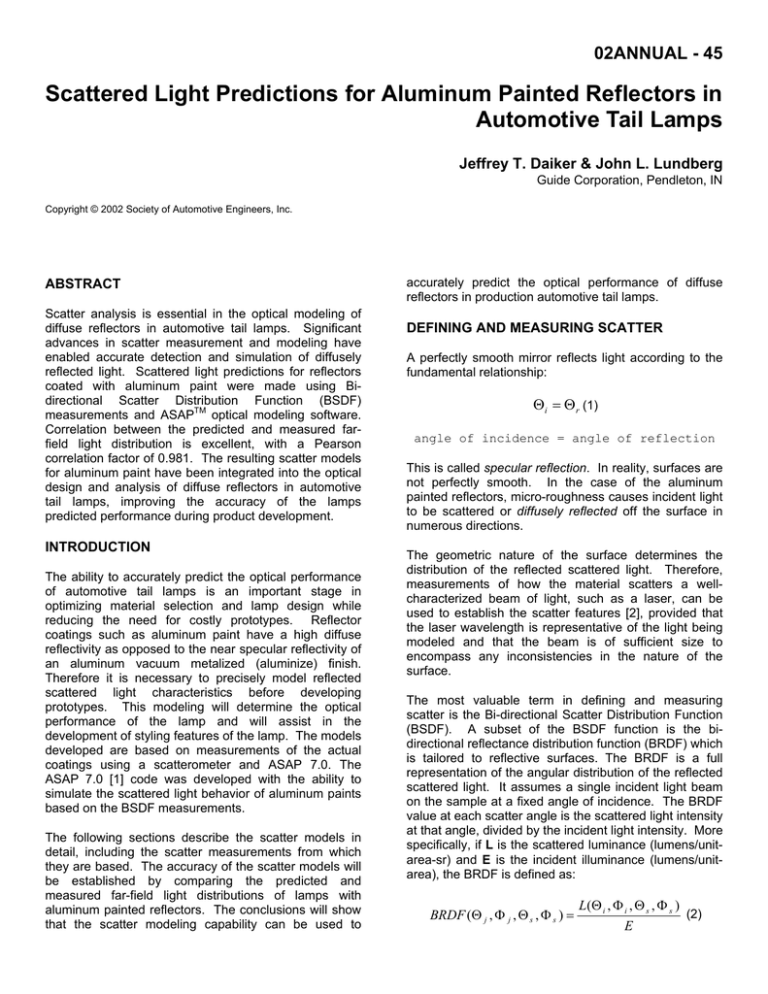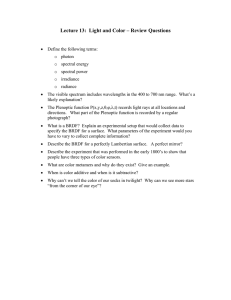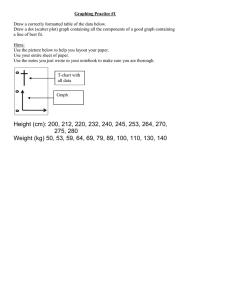Scattered Light Predictions for Aluminum Painted Reflectors in
advertisement

02ANNUAL - 45 Scattered Light Predictions for Aluminum Painted Reflectors in Automotive Tail Lamps Jeffrey T. Daiker & John L. Lundberg Guide Corporation, Pendleton, IN Copyright © 2002 Society of Automotive Engineers, Inc. ABSTRACT Scatter analysis is essential in the optical modeling of diffuse reflectors in automotive tail lamps. Significant advances in scatter measurement and modeling have enabled accurate detection and simulation of diffusely reflected light. Scattered light predictions for reflectors coated with aluminum paint were made using Bidirectional Scatter Distribution Function (BSDF) measurements and ASAPTM optical modeling software. Correlation between the predicted and measured farfield light distribution is excellent, with a Pearson correlation factor of 0.981. The resulting scatter models for aluminum paint have been integrated into the optical design and analysis of diffuse reflectors in automotive tail lamps, improving the accuracy of the lamps predicted performance during product development. INTRODUCTION The ability to accurately predict the optical performance of automotive tail lamps is an important stage in optimizing material selection and lamp design while reducing the need for costly prototypes. Reflector coatings such as aluminum paint have a high diffuse reflectivity as opposed to the near specular reflectivity of an aluminum vacuum metalized (aluminize) finish. Therefore it is necessary to precisely model reflected scattered light characteristics before developing prototypes. This modeling will determine the optical performance of the lamp and will assist in the development of styling features of the lamp. The models developed are based on measurements of the actual coatings using a scatterometer and ASAP 7.0. The ASAP 7.0 [1] code was developed with the ability to simulate the scattered light behavior of aluminum paints based on the BSDF measurements. The following sections describe the scatter models in detail, including the scatter measurements from which they are based. The accuracy of the scatter models will be established by comparing the predicted and measured far-field light distributions of lamps with aluminum painted reflectors. The conclusions will show that the scatter modeling capability can be used to accurately predict the optical performance of diffuse reflectors in production automotive tail lamps. DEFINING AND MEASURING SCATTER A perfectly smooth mirror reflects light according to the fundamental relationship: Θi = Θ r (1) angle of incidence = angle of reflection This is called specular reflection. In reality, surfaces are not perfectly smooth. In the case of the aluminum painted reflectors, micro-roughness causes incident light to be scattered or diffusely reflected off the surface in numerous directions. The geometric nature of the surface determines the distribution of the reflected scattered light. Therefore, measurements of how the material scatters a wellcharacterized beam of light, such as a laser, can be used to establish the scatter features [2], provided that the laser wavelength is representative of the light being modeled and that the beam is of sufficient size to encompass any inconsistencies in the nature of the surface. The most valuable term in defining and measuring scatter is the Bi-directional Scatter Distribution Function (BSDF). A subset of the BSDF function is the bidirectional reflectance distribution function (BRDF) which is tailored to reflective surfaces. The BRDF is a full representation of the angular distribution of the reflected scattered light. It assumes a single incident light beam on the sample at a fixed angle of incidence. The BRDF value at each scatter angle is the scattered light intensity at that angle, divided by the incident light intensity. More specifically, if L is the scattered luminance (lumens/unitarea-sr) and E is the incident illuminance (lumens/unitarea), the BRDF is defined as: BRDF (Θ j , Φ j , Θ s , Φ s ) = L (Θ i , Φ i , Θ s , Φ s ) (2) E where Figure 2. Reflectors coated with HLA paint, SHLA paint, and aluminize Θ j is the polar angle of incidence Φ j is the aziumuthal angle of incidence Θ s is the polar angle of scatter Φ s is the aziumuthal angle of incidence A typical configuration for a BRDF measurement system (scatterometer) is shown in Figure 1. A laser beam is focused onto the detector path after reflecting off a sample. The detector rotates in the plane of incidence about the illuminated scatter source on the sample. Figure 3. Composite tail lamp geometry HARVEY-SHACK MODEL - As a mathematical function, the Harvey-Shack model describes the BRDF as a function of the Figure 1. BRDF as a measurement of scattered light [3] SCATTER MODELING • • angle of detection, and angle of incidence of the beam that is used for the measurements. Consider the angles defined in the typical BRDF measurement as shown in Figure 4. Reflectors coated with High Lustre Aluminum (HLA) paint, Super High Lustre Aluminum (SHLA) paint, and aluminize are shown in Figure 2. The tail lamp used for the scatter model simulations is shown in Figure 3 and consists of the parabolic reflector and the signal bulb. Figure 4. Typical BRDF measurement [3] The angle of any measurement can be described as sinθ – sinθ0 (3), which is referred to as β – β0 .(4) For many materials, if you view a graph of log|BRDF| vs. log|β – β0| of the measured data, the result is linear. Figure 5 illustrates this type of graph [3]. rollover point max BSDF slope Most materials and surface treatments that are used in illumination applications fit the modified Harvey-Shack model, or a sum of two Harvey-Shack models. Examples include vacuum-metalized reflectors, aluminum painted reflectors, plastic injection-molded parts, and sand blasted or acid etched surfaces. DEFINING SUFACES IN ASAP – First, the BRDF data is fit with a Harvey-Shack model. We can then use the results to apply the scatter model to the reflector surfaces in ASAP. Figures 7 and 8 illustrate BRDF data and Harvey-Shack fit for an HLA painted sample at a measurement angle of incidence of 15 and 60 degrees respectively [1]. Notice that the BRDF data changes dramatically with respect to the angle of incidence of the beam which is used for the measurement. Laser location Figure 5. Harvey-Shack model fit to BRDF measurements of a plastic injection-molded sample, with a roughened surface [3] Note that most of the angular range of data (from the specular angle) falls on the slope. The graph consists of three lines. Two are data lines, which represent the measured forward and backward scatter as illustrated in Figure 6. The third line represents a modified version of the Harvey-Shack curve, which you define by assigning the three parameters as conveyed in Figure 5: Figure 7. BRDF data and Harvey-Shack fit for HLA painted sample. 15 degree angle of incidence [1] 1. maximum BRDF value, which determines the height of the plateau 2. rollover point in radians 3. slope of the fall-off line Figure 6. Forward and backward scatter as measured from specular [3] Figure 8. BRDF data and Harvey-Shack fit for HLA painted sample. 60 degree angle of incidence [1] The measured scatter outside two degrees from specular fits nicely to the modified Harvey-Shack model. The Total Integrated Scatter (TIS) in each case is more than sixty-five percent. Thus, the majority of the light is diffusely reflected off the surface [4]. HLA model - The results of the prediction for the lamp with an HLA painted reflector showed excellent correlation with the actual measurements as shown in Figure 10 [5]. An average correlation coefficient of 0.981 was achieved. In the analysis of illumination systems, if the optical surface is more diffuse than specular, a Monte Carlo ray trace (one ray in, one ray out) is not recommended [3]. Instead, a number of randomly distributed scattered rays are generated for each incident ray. The flux of each scattered ray is determined by flux of the incident ray and the BRDF of the surface that is appropriate to the ray’s incident and scatter directions. RESULTS Far-field light distribution predictions were made for lamps with HLA and SHLA painted reflectors. The predictions were then benchmarked against photometer measurements in order to verify the accuracy of the scatter models. The strength of the relationship between the predicted and actual far-field light distribution was measured by calculating the Pearson correlation coefficient described in Appendix A. This calculation was done using the OptiMaXTM 3.0 [5] optical design system. The correlation between the predicted and measured photometry is discussed in the following sections. Figure 10. Far-field light distribution comparison between the ASAP model and Photometer measurements for HLA painted reflector SHLA model - The results of the prediction for the lamp with an SHLA painted reflector showed excellent correlation with the actual measurements as shown in Figure 11 [5]. An average correlation coefficient of 0.976 was achieved. ALUMINIZE MODEL - In order to verify the accuracy of the scatter models it was necessary to validate the predicted far-field light distribution of a lamp with an aluminize reflector. The results of the prediction for the lamp with an aluminize reflector showed excellent correlation with the actual measurements as shown in Figure 9. A correlation coefficient of 0.975 was achieved. Figure 11. Far-field light distribution comparison between the ASAP model and Photometer measurements for SHLA painted reflector CONCLUSION Figure 9. Far-field light distribution comparison between the ASAP model and Photometer measurements for aluminize reflector ALUMINUM PAINT MODELS – Having validated the photometry of the lamp with an aluminize reflector, farfield light distribution predictions were made for lamps with aluminum painted reflectors. The first case was a lamp with a HLA painted reflector, while the second case was a lamp with a SHLA painted reflector. The results of the tail lamp scatter analysis have shown that highly accurate scattered light predictions can be achieved by using the ASAP code. The far-field light distribution predictions for aluminum painted reflectors were all within 10% of the photometric measurements. Advances in scatter measurement and the capability of BRDF data fitting using optical modeling software has greatly simplified the scatter modeling of aluminum paint. The validation of the tail lamp scatter analysis shows that it is now possible to accurately predict the optical performance of diffuse reflectors in production automotive tail lamps prior to building a prototype. Precision scatter measurement combined with the modified Harvey-Shack model will enable various reflector coatings to be evaluated and scattered light from these coatings to be accurately simulated. This will provide lamp designers with vital information early in the design stage so that optical performance issues may be addressed prior to production. DEFINITIONS, ACRONYMS, ABBREVIATIONS BSDF: BRDF: TIS: HLA: SHLA: Bi-directional Scatter Distribution Function Bi-directional Reflectance Distribution Function Total Integrated Scatter High Lustre Aluminum Super High Lustre Aluminum REFERENCES 1. ASAP Version 7.0, Breault Research Organization, Tucson, AZ, 2001 2. “Interpreting Light Scatter Measurements,” Schmitt Measurement Systems, Inc., Portland, OR, 1994 3. “Harvey-Shack Overview,” Breault Research Organization, Tucson, AZ, 2000 4. Bennett, J., and Mattsson, L., Introduction to Surface Roughness and Scattering, Optical Society of America, Washington, DC, 1989. 5. OptiMaX Version 3.0, Guide Corporation, Pendleton, IN, 2001 APPENDIX A VERFIFY CONDITIONS FOR USING PEARSON r Interval/ratio data must be from paired observations. A linear relationship should exist between the variables - verified by plotting the data on a scattergram. Pearson r computations are sensitive to extreme values in the data. COMPUTE PEARSON r n = number of paired observations X = variable A Y = variable B INTERPRET THE CORRELATION COEFFICIENT A positive coefficient indicates the values of variable A vary in the same direction as variable B. A negative coefficient indicates the values of variable A and variable B vary in opposite directions. CHARCTERIZATIONS OF PEARSON r .9 to 1 .7 to .9 .5 to .7 .3 to .5 .0 to .3 very high correlation high correlation moderate correlation low correlation little if any correlation Interpretation: There is a (insert characterization)(positive or negative) correlation between the variation of X scores and the variation of Y scores.



